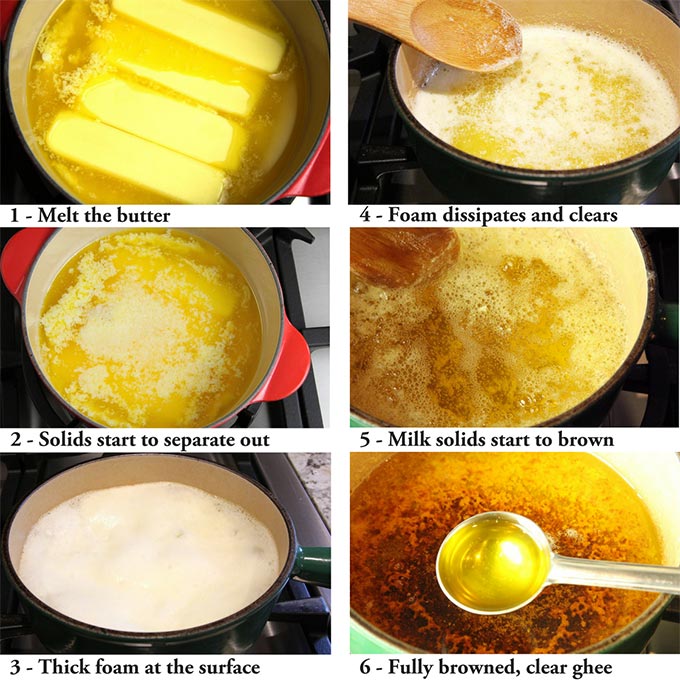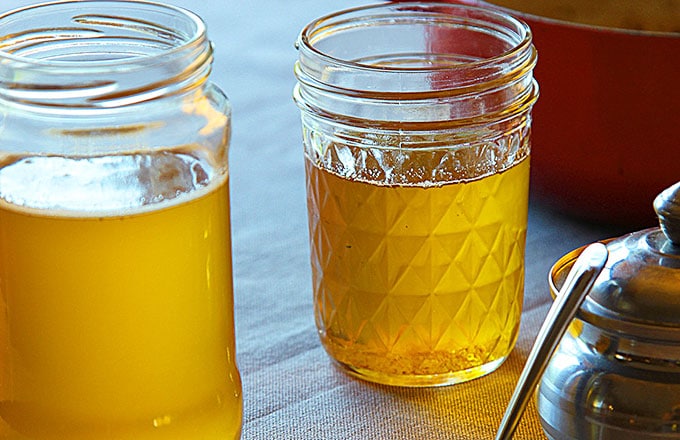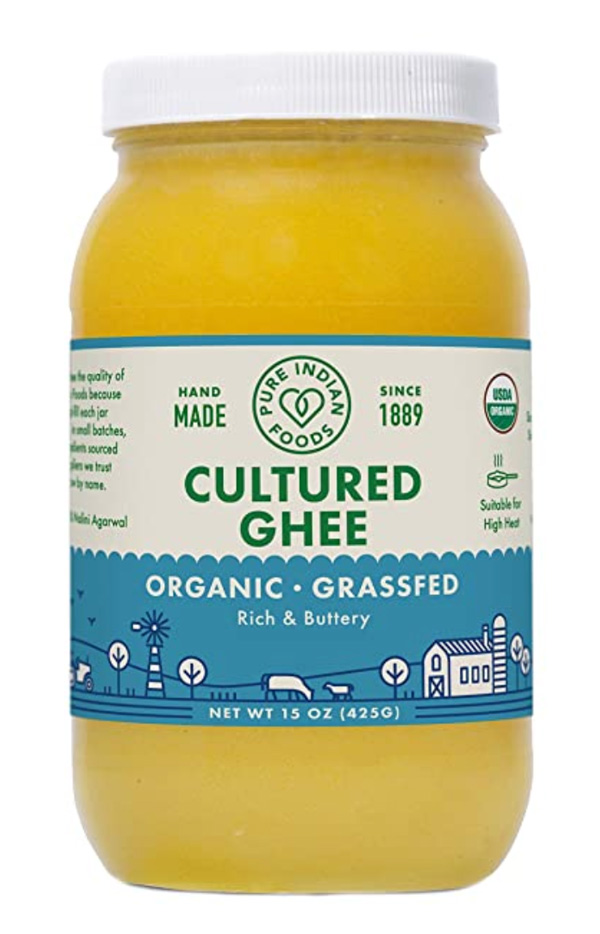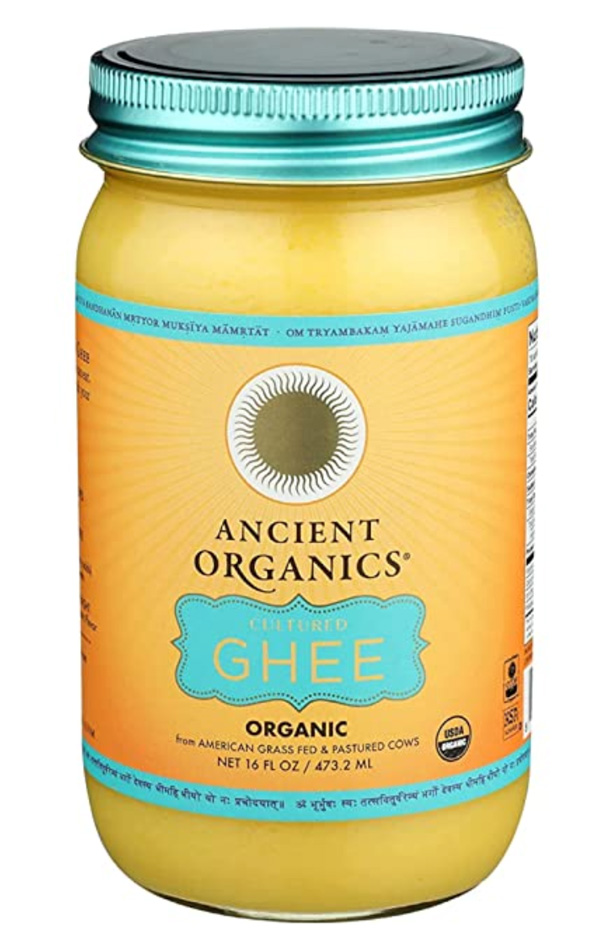This post may contain affiliate links. Please see our disclosure for more information.
Ghee is one of the healthiest foods on the planet, and in my opinion, it is the healthiest fat for daily cooking and consumption.

Most Ayurveda practitioners recommend cooking almost exclusively with ghee. They recommend ghee over coconut oil, over avocado oil, and even above olive oil.
Surprised? Why is this?
If you want the real facts about ghee from a traditional Ayurveda perspective, then read on.
There are 6 very good reasons why ghee is the healthiest choice you can make for yourself and your family, and they might surprise you.
- 1. Enhances digestion and assimilation of nutrients
- 2. Contains high concentrations of monounsaturated Omega-3s
- 3. Contains CLAs (conjugated linoleic acid)
- 4. Best fat for gut health, due to butyric acid
- 5. Best fat for hormonal health and fertility
- 6. A perfect balance of nourishing and detoxifying
- Conclusion
- How much ghee should I consume?
- GENERAL CONSUMPTION GUIDELINES:
- Where to Buy
- Recommended Recipes
1. Enhances digestion and assimilation of nutrients
Compared to the gut-wrecking results of refined vegetable oils, and the cold, heavy, waxy digestive challenges imposed by the likes of coconut and avocado oils, ghee is light, subtle, and easy to digest.
When butter is simmered over the fire in the process of making ghee, heat, and energy are infused into the fat.

The very refined and exciting molecules of pure butterfat contain cholesterol, but it’s the good kind, and it’s a good thing.
This is because the body’s cell membranes are also made of cholesterol.
It turns out that ghee is the cell’s best friend because the fat-soluble molecules your body needs for health are able to be carried into the cells by the ghee due to this cholesterol synergy.
This powerful health benefit has been known since ancient times.
This is why it is common practice to combine Ayurvedic herbs with ghee, and it is highly recommended to use ghee with herbs and spices in daily cooking.
The ghee helps to deliver the nutrition to your body cells, greatly enhancing the assimilation of nutrition from food, which is your primary source of energy.
2. Contains high concentrations of monounsaturated Omega-3s
According to Dr. Marianne Teitelbaum, Omega-3s and other nutrients in ghee prevent sticky plaque from attaching to the walls of the arteries.

Omega-3s are beneficial fats that help keep the arteries clean and prevent heart attacks.
One tablespoon of ghee contains 12% of Adequate Intake (AI) of Omega-3s and just 2% AI of Omega-6s.
AI is a measure for Omega 3s and 6s set by the U.S. Institute of Medicine.
In general, Americans consume far greater quantities of Omega 6s in vegetable oils, to the great detriment of their health.
Consumption of ghee helps to correct this imbalance.
3. Contains CLAs (conjugated linoleic acid)
CLAs help to burn fat and build muscle mass, which can support weight loss in some individuals.

CLAs also prevents inflammation in the artery walls and the hardening of arteries. Again, it appears ghee is a fat that supports heart health.
Ghee is a powerful natural source of CLA. This is especially so when the ghee is from grass-fed cows, and even more so when you consume cultured ghee.
Cultured ghee is harder to find, and a little more expensive.
You should know that regular ghee is made from regular butter, while cultured ghee is made from cultured cream that is churned into butter prior to making ghee.
It is said that cultured ghee has twice the quantity of CLAs than regular ghee.
>> Buy cultured ghee from this quality source.
4. Best fat for gut health, due to butyric acid
Butyric acid, or butyrate, is essential for gut health.
Butyrate plays two major roles in the gut.
The first relates to the gut’s function to protect the body from pathogens.

The gut is lined with a thick layer of protective mucus that acts as a shield to prevent pathogens from passing through the gut lining into blood circulation.
This mucus layer is created by what are known as goblet cells, and goblet cells receive their marching orders from butyrate.
The second major function of butyrate is to strengthen the gut lining itself. A weak gut lining is what is known as leaky gut.
The gut lining consists of very tight junctions held together by cells known as colonocytes.
Butyrate directly feeds these colonocytes, and keeps them healthy so that pathogens and undigested food molecules cannot escape and wreak havoc on the immune system.
Most of the butyrate in your body is created by the work of specialized friendly gut bacteria, but some butyrate also comes from food.
Unfortunately, there are very few food sources of butyrate.
However, it turns out that butter, ghee, and other dairy products are the top, top sources. Interesting right?
So your daily consumption of ghee is truly like taking a gut health supplement.
5. Best fat for hormonal health and fertility
Female hormones are made out of cholesterol, and ghee provides a highly absorbable and nourishing form of cholesterol to crank up women’s hormones, increase fertility, and nourish a developing fetus.

For these same reasons, ghee is the best fat to nourish brain health.
The avoidance of high-quality dairy products is a known factor in infertility in Ayurveda circles. Many practitioners report that women’s fertility shoots up after adding dairy back into the diet.
Ayurveda is very big on the correct consumption of dairy for overall health, and views animal protein as an essential component of a healthy vegetarian diet.
6. A perfect balance of nourishing and detoxifying
Anyone that has taken a traditional Ayurvedic cleanse will have experienced ghee as oleation therapy.

With oleation therapy, larger doses of ghee are used therapeutically to coat the bodily channels and protect them from toxins. At the same time, this ghee is drawing toxins out into these same channels.
This is the process of nourishing and detoxifying at the same time.
Whenever you consume ghee, you are getting this benefit.
This action is due to ghee’s subtle and refined nature that purifies, hydrates, and smoothes without clogging.
This is also why, despite ghee containing cholesterol, the correct consumption of ghee has not been shown to increase bad cholesterol when consumed in moderation.
In fact, it has been shown to reduce cholesterol.
Conclusion
As you have seen if you read this far, Ayurveda takes into account factors that aren’t considered by modern medicine.
I’d actually like to add a few more big ones. The first point is the accessibility of ghee.
Ghee is made from butter, and butter is readily accessible almost everywhere in the world. With butter in hand, anyone can make ghee at home in about an hour.

You don’t need any special tools or a manufacturing plant. This shows that ghee is a product that is minimally processed and very close to nature.
The next amazing thing about ghee is that ghee stays good in the cupboard for years as long as it’s kept dry. This came in handy in the past, and it very well may again.
Next is the very high smoke point of ghee, which is about 485 degrees Fahrenheit. This makes heat very safe and free from cancer-causing free radicals in most cooking applications.
Next is that many people who are lactose-intolerant can still consume ghee since the milk proteins are removed in the process of making ghee.
If this is important to you, you can find ghee that’s tested and certified with extremely low lactose content.
The final reason is how incredibly versatile and flavorful ghee is.
It can take some getting used to, but it is so similar to butter that most people find that they fall in love with it in short order.
How much ghee should I consume?
I have just extolled the virtues of ghee. This doesn’t mean that you should now increase your consumption and go overboard.

Ghee is meant to be consumed according to individual body type and digestive strength. Seasonality also matters.
Fats are highly nourishing and calorie-dense, so caution must be used. Too much of a good thing is no longer good.
Since fat is heavy, it needs to be consumed in a way that it is able to be digested. This means one needs good overall digestive strength, regular elimination, and an active lifestyle.
GENERAL CONSUMPTION GUIDELINES:
The following guidelines suggest a healthy amount of daily ghee consumption for healthy individuals based on body type and season.
If you have concerns or questions, you are encouraged to talk to your doctor or a licensed health professional.
Vata types who tend toward dehydration and deficiency can consume more ghee, up to 2 teaspoons a meal.
Pitta types who have strong hunger and digestion will do well with about 1 1/2 teaspoons per meal.
Kapha types who tend to have slower and sluggish digestion will do well with 1 teaspoon or less per meal.
- Fall/Winter: more ghee, like Vata
- Spring: less ghee, like Kapha
- Summer: medium ghee, like Pitta
Where to Buy
I encourage you to seek out the highest quality ghee you can find, and for me that is local, grass-fed, and most importantly: cultured.
Cultured ghee is said to contain up to 2 times the CLA as regular ghee. It will be a little bit more expensive, but your health is worth it!
I love New Jersey-based Pure Indian Foods for their ghee. This is a family owned business backed by the knowledge and wisdom of 5 generations of ghee-makers in India.
When you visit the link above, be sure to check out their other quality products.
Below are my ghee recommendations available on Amazon (affiliate links). I have used all of these products myself and checked out their sourcing practices. I generally recommend sourcing your ghee from grass-fed dairy cows in the United States.
Pure Indian Foods

This ghee sources grass-fed milk from US-raised cows.
Ancient Organics

This ghee sources grass-fed butter from California cows.
-> Grass-fed Ghee, from Ancient Organics
-> Cultured Ghee, from Ancient Organics
Sunrise Organics

This ghee sources grass-fed butter from US-raised cows.
Recommended Recipes








What a great article summarizing all the benefits of ghee, how to make it (or where to buy), and how much to consume depending on Ayurvedic constitutional type. Thank you Andrea! 🙂
Hi Annika,
Glad you found it helpful!
—Andrea